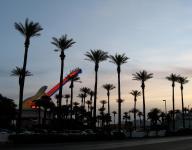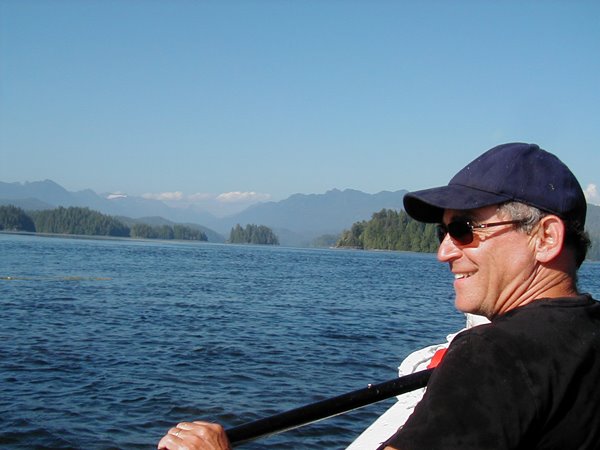
Ian's last day of Spring Break from Junior Kindergarten was the end of a taxing two weeks for me. April 1 was
Flora!, the Sierra Club Fundraiser I'd been planning and worrying about since January. The day after, I returned to teaching after a nine-months' recess. The day after that I launched a challenging new course on
Argumentation about Sustainability focussing on Gore's film,
An Inconvenient Truth. Last weekend was the Focus the Nation organizing conference in Las Vegas and the day after a press to write up my
report on it followed by nine more hours of lecturing on Tuesday, Wednesday and Thursday. The tough slog of grading the first set of English papers was on my schedule Friday. But the sky was bright blue and the hills were still green. Besides, I had required my Ecolit class to listen the poets' invitation to "Rise Up and Come Away," so I too was obliged to obey.
We drove along Foothill Blvd. through the threatened ranchland between Bishops Peak and San Luis Mountain thick with cows and calves trimming the pastures into glittering lawn. The open, black-soiled fields along Los Osos Valley Road seemed hungry for seed or ready to sprout. I asked Ian to repeat the name of the road. At first he struggled and then it rolled off his tongue. The mountains on both sides--Morros and Irish Hills--make this a Valley where the dirt rolls down and turns to soil that grows the crops, I explained. He recognized the rows of Snow Peas with their white polka dots that will turn into the sweet morsels we pick from the planter beside our deck. Los Osos means the bears in Spanish I told him, the name of the town at the end of the road. Watch for bears on either side. By the time we reached the turnoff to Montana De Oro, he'd counted 14--on signs, a mural, woodcarvings and the cast bronze sculpture by the bridge.

"Gwampa, wet's wace to the mountain," he called back to me from the beach. "I cant run with this backpack," I answered. I boosted him on to the ledge sloping up the outcrop, where he passed the time making sand waterfalls, while I struggled to find handholds in the strata to pull myself over the first hump.
After several clumsy efforts I realized I wouldnt make it, and he'd have to come down. I wondered if the cause was the soft rock's weathering since I'd been here last, or other sorts of weathering closer to home.
But there was no shortage of alternatives, and I remembered that last year several Cal Poly students had been swept into the water from this promontory by rogue waves, one to his death.

We noticed an alluring cave carved in the vegetation-covered cliff bordering the north side of the beach. Ian said, "that's a dinosaur cave." The creek that flowed to the sea at the foot of the cliff was low enough to hop with dry shoes. Ian led the way up another sloping ledge into what turned out to be a tunnel rather than a cave, with a perfectly formed arched opening to the sky. We passed through slowly and came around the back to perch on a ledge that looked straight down into the surf, which pounded with a force that carved these rocks like cheese. I kept a tight grip on the rolled-up waistband of his sweatshirt. In the wind-pruned scrub above the cove behind the tunnel, a flourescent red-throated finch burbled above the waters' roar.

On the way back through the tunnel, we found another tunnel at the base of its lower, landward, wall, this one squat and deep. Through it one could see foamy water flowing in and out of the shadowed cove below the finch's perch. One could easily slide down there, but with no way of return.
Back outside, we saw a possible route upward: vertical footholds in the rock leading to an oval opening in the brush that looked like the start of a trail into the dunes. This might be the dinosaur's exit. Ian led the ascent and I followed him through the green tube.

It daylighted at a wooden railing marking a sand trail bordered by blooming bush poppies and silver lupine. A fork of the trail covered with delicate lizard tracks led toward the water and traversed the dune.
Up steep switchbacks and down muddy seeps, we made our way to tidepools and blowholes. Across the expanse of Spooner's Cove, we saw groups of walkers on the popular cliff trail, but here there was no one.



I looked at my watch: 11:30. I had an appointment at the Social Security Office to apply for Medicare. Ian was getting hungry. Off the rocks and up the sand we rambled. On the warm trail that circled back to Reddy in the parking lot, over and over we sang "Dinah wontcha blow."

 When I opened the curtain at 5:45 there was already a blue-gray glow in the western sky. We’re a third of the way to the solstice. I wont wake up in the dark anymore till August.
When I opened the curtain at 5:45 there was already a blue-gray glow in the western sky. We’re a third of the way to the solstice. I wont wake up in the dark anymore till August. My perch is a new seat in the garden, three quarters of the way up the bank above the grape arbor at a switchback in the south trail. I decided to carve it out of the adobe clay on Saturday while sprucing up the yard to prepare for our big party this weekend.
My perch is a new seat in the garden, three quarters of the way up the bank above the grape arbor at a switchback in the south trail. I decided to carve it out of the adobe clay on Saturday while sprucing up the yard to prepare for our big party this weekend. I’ll be returning to this spot nestled between a Channel Island Ironwood and a Sugarbush.
I’ll be returning to this spot nestled between a Channel Island Ironwood and a Sugarbush.












